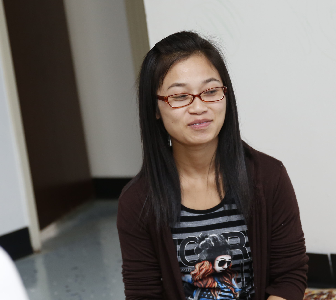
Tin Tin Aye sits on the floor in her Iowa apartment, laughing and stacking building blocks with her son who’s almost two. Her bright smile camouflages the chaos that drove her from her family and her country as a child.
At 12, she fled Burma alone in search of safety and an education. “It was very scary. I worried that if I got sick, no one would take care of me,” said Tin Tin, now 25. But staying home was even more frightening. “We lived in a small village. The Burmese soldiers always came to our village. We had to run and escape. They burned all the rice and the houses and we had to rebuild. It is hard for kids to go to school and there was always the fear of the Burmese soldiers coming back and destroying things,” Tin Tin said through an interpreter.
For eight years, Tin Tin lived in a refugee camp in Thailand and had no contact with her family. In 2012, she received the opportunity to come to the U.S. She now lives in Des Moines with her husband, a fellow refugee, and their son, Jason.
Life in the U.S. is both amazing and challenging. One of the best surprises is the support she has received from Nurse-Family Partnership. The fifth of nine children, Tin Tin remembers her mother giving birth in their primitive home in Burma. “There was no hospital. A woman came to the house. I heard my mom scream very loudly and it scared me.”
After a new baby arrived, Tin Tin’s mother had to manage on her own. While infant mortality rates are very high in countries where war and genocide spur people to flee, all of Tin Tin’s siblings survived and she enjoyed an emotional reunion with her family last year in Thailand.
But fear of childbirth can be common among refugees. That makes education from nurses all the more essential since they can reassure nervous moms about pregnancy and new babies.
“We were very poor. No one came to the house. I am very glad I have all these services available to me.” Tin Tin is one of a growing number of refugees across the U.S. who are receiving long-term support from Nurse-Family Partnership. Many, like Tin Tin, are Karen: a persecuted ethnic group, thousands of whom have fled to the U.S. in recent years. The flood of Karen refugees began in about 2008. In recent years, more Karen refugees have resettled in the U.S. than refugees from any other country. Tin Tin bonded quickly with her nurse, Amanda Devereaux of Visiting Nurse Services of Iowa.
“She has helped me with everything, counting kicks and having a healthy pregnancy. She helps me with OB appointments and food assistance,” Tin Tin said. The language barrier is challenging, especially when the two are trying to discuss complex concepts. But an interpreter accompanies Amanda on all visits with non-English speakers, who now comprise one-third of her caseload.
“They want to learn everything, like how your baby can hear you. We have these little fetal models. Many have never seen an ultrasound picture before. It’s hard to imagine that you’ve never seen what a baby looks like in utero,”
Amanda said. Several hundred miles away in South Dakota, the rural town of Huron, population 13,133, has become an unlikely haven for Karen refugees. A turkey processing plant called Dakota Provisions found Karen refugees to be excellent workers. So the company sponsored refugees and more kept coming. Today at least 2,000 of Huron’s residents are Karen, giving the town one of the highest concentrations of Karen refugees anywhere in the U.S.
As the influx accelerated, the Nurse-Family Partnership program under South Dakota’s Department of Health adapted. Shelly Freese is the nurse supervisor at the Bright Start Home Visiting Program. She raves about all that her two nurses have done to better serve Karen clients since their rural team launched in 2013.
Every month, nurses Amy Mattke and Desiree Rand attend new refugee orientations at a local church. They have toured the turkey plant, visited Karen church services, soccer games and New Year’s celebrations and have offered hospital tours for all non-English speaking pregnant women.
The team has translated as many documents as possible into Karen including consent forms, program information and menus. The nurses have learned to write the days of the week in Karen and try to greet their clients with a few words in Karen.
The biggest breakthrough is coming now with in-person interpreters. In the past, there have been some funny miscommunications, including one with a male phone interpreter. Along with being a nurse, Amy is also a lactation consultant and on one visit, brought a model of a breast. She showed it to her client and said, “This is my breast and this is how you put the baby to the breast.”
The phone line went dead silent.
“The mom and I were dying laughing. The interpreter thought I just whipped out my breast,” Amy said.
Both nurses have found that clients engage more and ask more questions with in-person interpreters.
While communication is the biggest challenge, Amy and Desiree say their clients are dedicated mothers who benefit from supportive families. They revere nurses and consider a home visit a great honor. Often at a first appointment, 15 family members will gather around.

